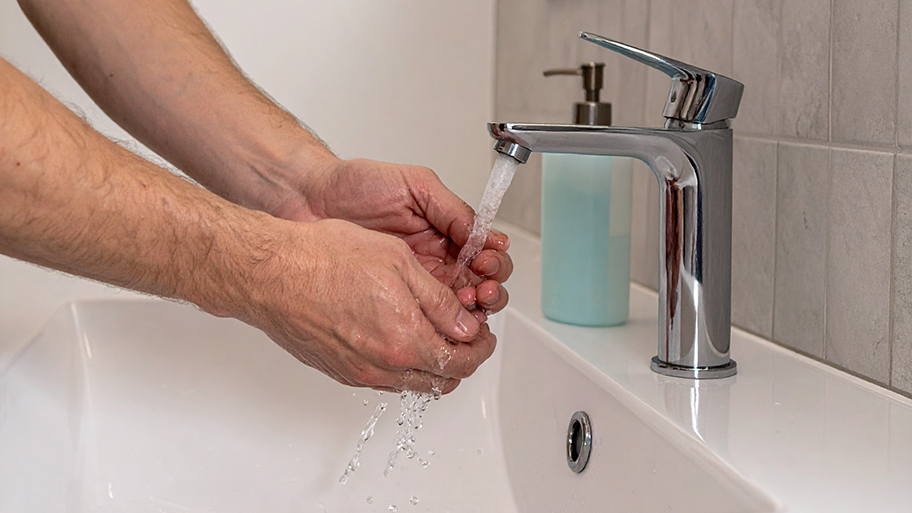
Everyone can relate to having toilet issues—we’ve all been there. There are several reasons why your toilet might need repairs, and the cost varies based on the damage.
Flush out your toilet handle problems with these simple fixes


No one likes to discover a broken toilet handle in their home. But the good news is that most homeowners can fix a broken toilet handle themselves with just a few tools and supplies. If you want to save money on a professional plumber, use this guide to diagnose and fix your toilet handle problem or replace the handle with a new one.

No matter your toilet handle problem, the first step to fixing it is to turn off the water using the shut-off valve behind the toilet. Also known as the stop or supply valve, the shut-off valve is typically a round or oval knob protruding from the wall or floor behind the toilet. To turn the water off, turn the valve clockwise until it won't turn anymore.
Once the water is off, flush the toilet to drain the tank. This step will prevent water from spilling out while you're working and make it easier to access the toilet's components. Then carefully remove the tank lid and set it on a towel or other soft surface.
Now that you turned off the water and drained the tank, it's time to fix the handle problem. The steps for doing so will depend on what, exactly, is wrong with the handle.
If your handle is too loose or wobbly, look inside the tank for the arm that attaches to your toilet's flush handle. At the base of that arm, you'll find a nut that secures the arm to the toilet. Usually made of plastic, but sometimes metal, the nut is likely reverse threaded, which means you'll need to turn it clockwise to loosen it or counterclockwise to tighten it.
Use pliers or a wrench to loosen or tighten the nut until the flush handle arm is better secured and no longer wobbly. Just take care not to over tighten it—it should be just tight enough to fully secure the arm.
When you look inside the tank, you'll notice a chain or wire that connects your toilet's flush handle to a flapper at the bottom of the tank. If this chain is loose or detached, it prevents the toilet from flushing properly.
If the chain is no longer attached, simply reattach it to either the flapper or handle arm, depending on where it's detached. If the chain is properly attached on both ends but it's not taut, you can shorten it by moving the hook or clip that attaches it to the handle arm to a higher point on the chain or wire.
Over time, mineral deposits and rust can accumulate on a toilet handle—especially if you have hard water—which can cause the toilet handle to stick. If you suspect this is the case, inspect the handle's components for any mineral buildup or corrosion. If you notice any, mix a solution of one part water and one part vinegar, then use a cloth or brush to scrub the affected areas until clean.
If your flush handle has broken components, like a cracked nut or a broken handle arm, it's usually easiest to replace the whole handle. You can buy a handle replacement kit from the hardware store.
To remove the existing handle, use a wrench or pliers to unscrew the handle nut at the base of the tank. This nut is likely reverse threaded so you'll probably need to turn it clockwise to loosen it. Then remove the handle.
Once you remove the old handle, replace it with the new handle from your replacement kit. Attach the handle arm to the base of the tank by sliding the washer onto the arm, followed by the handle nut. Then use pliers or a wrench to turn the handle nut counterclockwise to tighten it. But don't tighten it too much since doing so can crack the porcelain.
Finally, attach the chain or wire to the flapper and the handle arm. The chain should be taut but not so taut that the flapper can't close. You can adjust the chain's length by moving the hook or clip that comes with it up or down.

Once you've diagnosed and fixed the problem, turn the water shut-off valve behind the tank back on and let the tank refill. Flush the toilet to ensure it's working, then put the lid back onto the tank.
Many homeowners can fix common toilet handle problems themselves with just a few tools and supplies and a free afternoon. Since professional plumbers charge between $40 and $200 per hour, you can save some money by tackling this project yourself. But if you're not comfortable with the steps to fix it or you simply don't want to spend the time, you can always call a local toilet repair company to fix it.
Nikan Plumbing did an amazing job on my kitchen remodel! Their team was professional, efficient, and paid close attention to every detail. The plumbing work was flawless, and they made sure everything was completed on time and within budget. I?m beyond satisfied with the results and highly...
KAS installed all new Andersen windows, replaced entry doors and repaired the roof. Excellent work, timely and efficient. A pleasure to work with them.
Good to work with trust haven solution they provided good service for my computer I will also recommend their services to others also. They are very timely with their monthly checks and reminders to have service completed.
A very good company to work with: professional, reasonably priced, and willing to go above and beyond to satisfy the customer. We had rotted wood and new aluminum roof trim installed, and the result is perfect and done on time. I definitely recommend them and will certainly use them for...
Professional, friendly service, good workmanship at good vale. As most know, plumbing services are expensive; Ruma Plumbing will offer much better pricing with equally or better work than big name competitors.
Chris did a great job with plumbing repair of coupling to pump. He also took time to answer many questions about other issues i wanted to repair myself.
Joel Long is professional, knowledgeable, and friendly. He explained everything that needed to be done to repair/replace piping, the flange and installed a new toilet. I will use Joel for all future plumbing issues. I highly recommend Longs Plumbing Services.
The service was excellent! Norwin's trap caught the dangerous bob cat in short order. I am very thankful!
Brandon Burnette did such a great job. I'm so happy I had him as my worker today. Very nice and friendly young man. 10 star in my book.
We had LHR install a new roof and gutter system. While they were not the cheapest, they were considered the most reliable and fetish for using only high-value products that would last for many years. Additionally, they were highly professional and never tried to push their services or any...
From average costs to expert advice, get all the answers you need to get your job done.

Everyone can relate to having toilet issues—we’ve all been there. There are several reasons why your toilet might need repairs, and the cost varies based on the damage.

Pipe leak repair costs depend on the location and severity of the leak, as well as the type of pipe being replaced. Use our guide to price out repair work.

The cost to replace cast iron pipes depends on many factors, like size and accessibility. Use this guide to get a rough idea of how much you’ll spend.

Replacing or upgrading plumbing in your home? Make sure you know how to measure pipe size accurately to avoid buying the wrong materials.

Plumbing a bathroom starts with knowing the steps for a successful DIY project. Follow this guide to learn how to plumb a bathroom yourself.

Need to create a residential plumbing design layout but don’t know where to start? Learn essential plumbing components to create the perfect layout for your home.